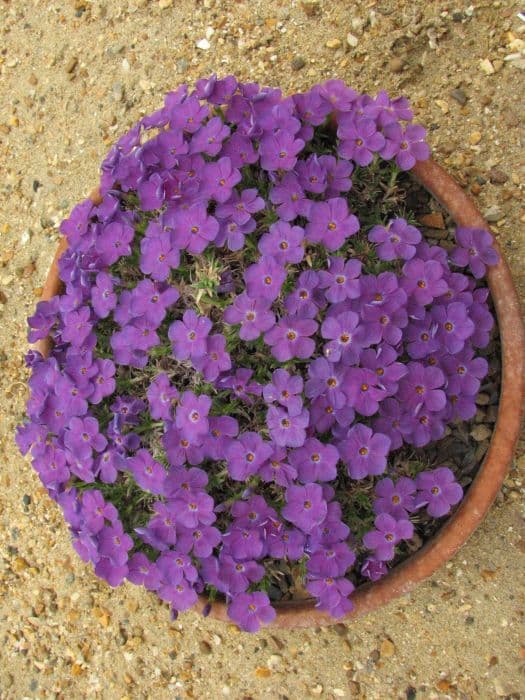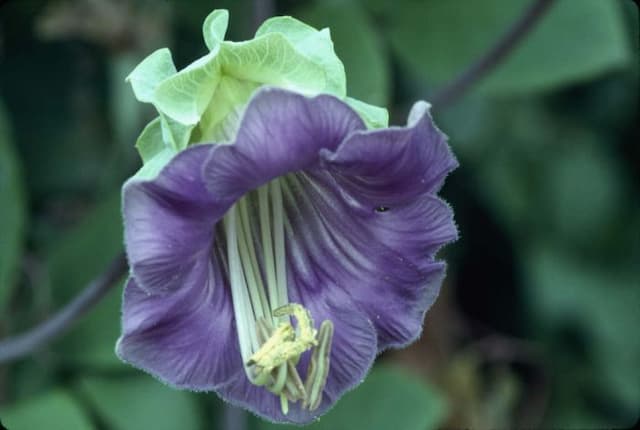Kelsey's Phlox Phlox kelseyi 'Lemhi Purple'

ABOUT
The Phlox kelseyi 'Lemhi Purple', commonly known as Kelsey's phlox, is a striking perennial that boasts a dense cluster of vibrant purple flowers. Each bloom displays a harmonious five-petaled form, coming together in a showy display that can catch the eye of any garden visitor. The petals have a delicate texture and are noticeably veined, which adds depth and character to the flower's appearance. Nestled at the base of these purplish blooms is a cushion of dark green foliage. The leaves are small and needle-like, giving the plant a fine-textured look that provides a nice contrast against the softness of the petals. This foliage often forms a mat-like groundcover that spreads outwards, with the colorful blooms rising slightly above it. The color of the flowers is particularly notable for its rich hue that ranges from a deep, royal purple to a lighter lavender, depending on the light and surrounding conditions. The overall impression of Kelsey's phlox is one of charm and vibrancy, with the intense purple flowers standing out against the greenery of the garden. It's a plant that adds a pop of color and a touch of wild beauty wherever it is grown.
About this plant
 Names
NamesFamily
Polemoniaceae
Synonyms
Lemhi Purple Phlox, Kelsey's Phlox
Common names
Phlox kelseyi 'Lemhi Purple'.
 Toxicity
ToxicityTo humans
Phlox kelseyi 'Lemhi Purple', commonly known as Kelsey's phlox, is not generally considered to be toxic to humans. However, it is always advisable to avoid ingesting plants that are not explicitly intended for human consumption, as individual responses can vary. There's no well-documented toxicity or symptoms associated with ingesting this particular variety of phlox. Nevertheless, if any part of the plant is consumed in significant amounts, it is best to seek medical advice, especially if any adverse reactions are observed.
To pets
Kelsey's phlox is not known to be toxic to pets. While it is generally safe around animals, it is still recommended to prevent pets from ingesting this or any ornamental plant as a precaution. If a pet consumes a notable quantity of the plant and experiences symptoms such as vomiting, diarrhea, or unusual behavior, it is prudent to consult with a veterinarian.
 Characteristics
CharacteristicsLife cycle
Perennials
Foliage type
Deciduous
Color of leaves
Green
Flower color
Purple
Height
6 inches (15 cm)
Spread
9 inches (23 cm)
Plant type
Herb
Hardiness zones
4
Native area
North America
Benefits
 General Benefits
General Benefits- Attracts pollinators - The vibrant purple flowers of Phlox kelseyi are known to attract bees, butterflies, and other pollinating insects, contributing to the health and diversity of your garden's ecosystem.
- Drought resistant - Once established, this plant is relatively drought-tolerant, making it an excellent choice for xeriscaping or areas that experience water scarcity.
- Easy to grow - Phlox kelseyi is a low-maintenance plant that is generally easy to care for, requiring minimal attention once established in proper growing conditions.
- Ground cover - With its low-growing habit, this plant can function as an effective ground cover, controlling weeds and preventing soil erosion.
- Landscape aesthetic - The 'Lemhi Purple' variation of Phlox kelseyi provides a splash of color with its deep purple flowers, improving the overall aesthetic of gardens and landscapes.
- Hardy - This species of phlox is known for its hardiness, capable of surviving tough winters and returning each spring, which can be beneficial for gardeners in cooler climates.
 Medical Properties
Medical PropertiesThis plant is not used for medical purposes.
 Air-purifying Qualities
Air-purifying QualitiesThis plant is not specifically known for air purifying qualities.
 Other Uses
Other Uses- Educational tool in botany and horticulture classes to demonstrate growth habits and characteristics of the Polemoniaceae family.
- Incorporated into sensory gardens for its texture and vibrant color to stimulate the senses.
- Used in dye-making workshops as a natural source of color for fabrics or crafts.
- Studied in ecology and conservation classes to discuss the importance of native species in ecosystem health.
- Featured in photography and painting classes for practicing capturing the rich purples of 'Lemhi Purple' in various light settings.
- Added to floral arrangements, whether fresh or dried, to provide a unique color and texture contrast.
- Utilized in culinary classes to explore edible flower use, provided they are confirmed safe for consumption.
- Employed in companion planting to take advantage of its ability to attract pollinators like butterflies and bees.
- Incorporated into children's gardens to teach plant life cycles from germination to flowering.
- Used in landscape design competitions for its aesthetic contribution as a low-growing, colorful groundcover.
Interesting Facts
 Feng Shui
Feng ShuiThe Kelseyi Phlox is not used in Feng Shui practice.
 Zodiac Sign Compitability
Zodiac Sign CompitabilityThe Kelseyi Phlox is not used in astrology practice.
 Plant Symbolism
Plant Symbolism- Unity and Harmony: Phlox generally symbolizes unity and harmony, making it an appropriate gift to express the sentiment of solidarity or to celebrate the joining of two people or groups.
- Agreement: The flower further indicates agreement, perhaps due to its clusters of blossoms that stick together in a harmonious fashion, mimicking a group in accord with one another.
- New Beginnings: Its blooms in the early spring can represent new opportunities, making it a suitable plant to mark fresh starts or new ventures.
- Partnership: With its bunches of flowers, phlox can also represent the idea of partnership and working together, typically used in weddings and other collaborative celebrations.
 Water
WaterLemhi Purple Phlox should be watered deeply but infrequently, encouraging it to develop a strong root system. Generally, this means watering the plant once a week with about one inch of water, depending on weather conditions. If the weather is particularly hot and dry, you may need to water more frequently, while in cooler or rainy periods, less watering is required. Ensure that the soil is allowed to dry out slightly between waterings to prevent root rot. During the growing season, a total of approximately 0.5 to 0.75 gallons per week per plant is usually sufficient, adjusted for rainfall and temperature.
 Light
LightThe Lemhi Purple Phlox thrives in full sun to partial shade. The ideal spot for this plant is an area where it receives at least six hours of direct sunlight daily. However, in hotter climates, some afternoon shade is beneficial to prevent scorching. Avoid deep shade, as it can lead to leggy growth and fewer blooms.
 Temperature
TemperatureThe Lemhi Purple Phlox is hardy and can handle a range of temperatures, but it performs best when the daytime temperature is between 60 and 75 degrees Fahrenheit. At night, it can tolerate temperatures down to 40 degrees Fahrenheit, and it is winter hardy to -30 degrees Fahrenheit. Avoid placing it in areas where temperatures can soar much above 80 degrees without providing some afternoon shade.
 Pruning
PruningPruning of Lemhi Purple Phlox is done to promote a bushier plant and to remove spent flowers, encouraging a second bloom. Pinch back the tips in the spring when the plant is about 6 inches tall. After the first major bloom, trim off the dead flower heads to tidy the plant and encourage additional flowering. The best time for major pruning is in late winter or early spring before new growth starts.
 Cleaning
CleaningAs needed
 Soil
SoilKelsey's Phlox thrives in well-draining soil with a pH range of 5.5-7.0. A good soil mix for 'Lemhi Purple' would be a blend of garden soil, compost, and a light, gritty material like perlite or sand, which ensures adequate drainage while providing organic matter to support its growth.
 Repotting
RepottingKelsey's Phlox does not typically require frequent repotting. Repotting every 2-3 years or when it outgrows its current container is sufficient to maintain the health of 'Lemhi Purple'.
 Humidity & Misting
Humidity & MistingKelsey's Phlox prefers average humidity levels. It is adaptable and does not require specific humidity conditions to thrive, making it suitable for many garden environments without the need for humidity adjustments.
 Suitable locations
Suitable locationsIndoor
Place Kelsey's Phlox in bright, indirect light inside.
Outdoor
Plant Kelsey's Phlox in full sun to partial shade.
Hardiness zone
4-8 USDA
 Life cycle
Life cycleThe life cycle of Phlox kelseyi 'Lemhi Purple' begins with seed germination, typically occurring in late winter to early spring when temperatures become conducive to growth. Following germination, the seedlings develop their first true leaves and establish a root system. As the plant enters the vegetative stage, it develops a rosette of leaves and starts to form a network of stems. Heading into late spring to summer, Lemhi Purple transitions to the flowering stage, producing vibrant purple blossoms that attract pollinators. After pollination, the plant sets seed, which eventually mature and are dispersed in late summer to fall. The plant may die back in winter, especially in colder climates, entering a period of dormancy before resuming its cycle with the next growing season.
 Propogation
PropogationPropogation time
Spring-Early Summer
Propogation: The most popular method of propagating Phlox kelseyi 'Lemhi Purple', commonly known as Lemhi Purple Phlox, is through stem cuttings. The ideal time for taking cuttings is in late spring to early summer when the plant is actively growing. To propagate, a gardener should select a healthy, non-flowering stem and cut a 4 to 6-inch (approximately 10 to 15 cm) segment just below a leaf node. It is important to use a sharp, clean knife or pair of scissors to make a clean cut, which helps prevent infection. The lower leaves are then removed, and the cut end can be dipped in rooting hormone to encourage root growth. The cutting should be planted in a pot filled with a well-draining soil mix, ensuring at least one leaf node is below the soil surface to facilitate root development. The pot should be kept moist and placed in indirect sunlight until the cutting has rooted, which usually takes a few weeks.









